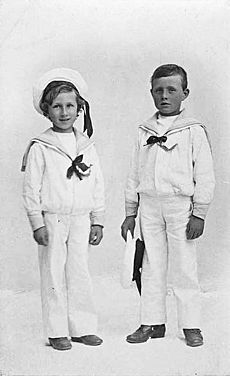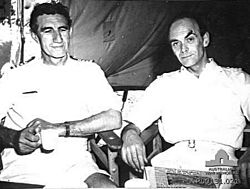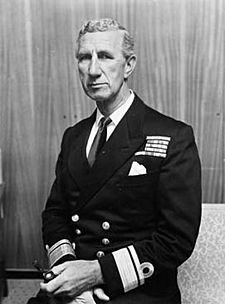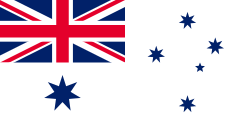Alan McNicoll facts for kids
Quick facts for kids
Sir Alan Wedel Ramsay McNicoll
|
|
|---|---|
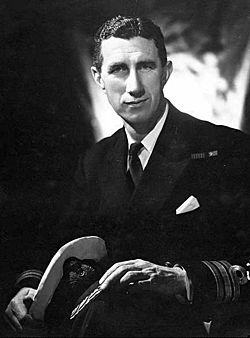
Commander Alan McNicoll c. mid-1940s
|
|
| Born | 3 April 1908 Hawthorn, Victoria |
| Died | 11 October 1987 (aged 79) Canberra, Australian Capital Territory |
| Allegiance | Australia |
| Service/ |
Royal Australian Navy |
| Years of service | 1922–1968 |
| Rank | Vice Admiral |
| Commands held | Chief of Naval Staff (1965–68) HM Australian Fleet (1962–64) HMAS Australia (1952–54) Deputy Chief of Naval Staff (1951–52) HMAS Warramunga (1950) HMAS Shoalhaven (1949–50) |
| Battles/wars | Second World War
Indonesia–Malaysia confrontation Vietnam War |
| Awards | Knight Commander of the Order of the British Empire Companion of the Order of the Bath George Medal Commander of the Order of Orange-Nassau (Netherlands) |
| Relations | Brigadier General Sir Walter McNicoll (father) Major General Ronald McNicoll (brother) |
| Other work | Australian Ambassador to Turkey (1968–73) |
Vice Admiral Sir Alan Wedel Ramsay McNicoll (3 April 1908 – 11 October 1987) was a very important officer in the Royal Australian Navy (RAN). He also served as a diplomat later in his life. Born in Melbourne, Australia, he joined the Royal Australian Naval College when he was just thirteen years old. He graduated in 1926 and continued his training in Australia and the United Kingdom.
When Second World War began, McNicoll was serving with the Royal Navy. He became a torpedo officer in the Mediterranean Sea. In 1941, he received the George Medal for bravely disarming enemy bombs. He served on the battleship HMS King George V from 1942, helping to protect ships in the Arctic convoys and taking part in the Allied invasion of Sicily. After the war, he held many important commands, including leading the Australian Fleet.
His career reached its highest point when he became Chief of Naval Staff in 1965. In this role, he helped modernize the Australian fleet and oversaw the Navy's involvement in the Vietnam War. He also helped create the Australian White Ensign, the official flag for Australian Navy ships. After retiring from the Navy in 1968, he became Australia's first Ambassador to Turkey. Sir Alan McNicoll passed away in 1987 at the age of 79.
Contents
Alan McNicoll was born in Hawthorn, a suburb of Melbourne, on 3 April 1908. His father, Walter McNicoll, was a school teacher and a military officer. Alan was educated at Scotch College, Melbourne and later at The Scots College in Sydney.
On 1 January 1922, when he was thirteen, Alan joined the Royal Australian Naval College at Jervis Bay. He was a very good student and athlete, excelling in his studies and sports. He graduated in 1926 and then went to Britain for more training with the Royal Navy.
In 1928, he became an acting sub-lieutenant. He returned to Australia the next year and served on ships like HMAS Australia. He did very well in his Lieutenants' Examinations in 1929, earning top marks. In July 1930, he was promoted to lieutenant. After serving on HMAS Canberra, he decided to specialize as a torpedo officer. He went back to the United Kingdom for special training at the Britannia Royal Naval College. While there, he also wrote a book of poems about naval life called Sea Voices.
In 1935, McNicoll returned to Australia. He served on HMAS Canberra, HMAS Sydney, and HMAS Cerberus. He was promoted to lieutenant commander in April 1938. In May 1937, he married Ruth Timmins. In March 1939, he was sent back to the Royal Navy's torpedo school, HMS Vernon. He was serving there when the Second World War started. Alan and Ruth later had two sons, Guy and Anthony, and a daughter, Deborah.
Serving in World War II
On 14 September 1939, soon after World War II began, McNicoll was assigned to HMS Victory. In April 1940, he joined the light cruiser HMS Fiji. The ship was badly damaged by a torpedo in September, but managed to return to port.
In October 1940, McNicoll moved to HMS Medway, a submarine support ship in Egypt. He became the torpedo officer for the 1st Submarine Flotilla, which operated in the Mediterranean Sea. His job also included safely disarming enemy bombs and torpedoes. Once, he had to disarm eight badly rusted torpedoes from a captured Italian submarine. For his "brave and fearless devotion to duty" in this dangerous task, McNicoll was awarded the George Medal in July 1941.
In April 1942, McNicoll transferred to the battleship HMS King George V. This ship helped protect several Arctic convoys, which were groups of supply ships sailing through dangerous waters. In May 1942, HMS King George V accidentally collided with a destroyer called HMS Punjabi in thick fog. The Punjabi sank, and HMS King George V was damaged but repaired.
In December 1942, HMS King George V supported another convoy to Russia. In May 1943, the ship moved to the Mediterranean Sea to prepare for Operation Husky, the Allied invasion of Sicily. McNicoll was promoted to commander on 30 June 1943. He took part in the Sicilian invasion the next month, with HMS King George V providing cover. Before the invasion, the battleship also fired its guns at targets in Sicily as a trick to confuse the enemy.
In October 1943, McNicoll was transferred to the British Admiralty in London for staff duties. He helped plan the Normandy landings, a huge invasion of Europe. On 15 February 1944, King George VI personally presented him with his George Medal at Buckingham Palace. McNicoll returned to Australia in October 1944 and stayed there for the rest of the war. His three brothers also served in World War II.
Senior Leadership Roles
Leading Ships as Captain
After the war ended, McNicoll became the executive officer of the light cruiser HMAS Hobart in September 1945. For nine months, HMAS Hobart operated in Japanese waters as part of the British Commonwealth Occupation Force.
In January 1948, McNicoll became the Director of Plans and Operations at the Navy Office in Melbourne. He was promoted to captain in June 1949. Two months later, he took command of the frigate HMAS Shoalhaven and also led the 1st Frigate Squadron. In January 1950, McNicoll took command of the destroyer HMAS Warramunga.
When the Korean War began in June 1950, HMAS Warramunga was chosen to join the conflict. However, McNicoll was replaced by another officer so that the ship could be led by a lower-ranked officer when working with British destroyers. McNicoll then moved to the Navy Office to help with the new National Service program in the Australian military. In October 1951, he became Deputy Chief of Naval Staff.
In 1952, McNicoll was chosen to lead the planning committee for the British nuclear tests on the Montebello Islands off Western Australia. Later that year, he became the commanding officer of the heavy cruiser HMAS Australia. He commanded the ship for two years. HMAS Australia was nearing the end of its service and was mainly used for training.
In 1954, McNicoll was made a Commander of the Order of the British Empire for his work on the British atomic program. Queen Elizabeth II presented him with this award. HMAS Australia's last duties included escorting the Royal Yacht Gothic during Queen Elizabeth II's visit to Australia. The ship also transported the Governor-General, Sir William Slim, on a cruise. During this cruise, HMAS Australia towed a Dutch naval ship that was in trouble near Hollandia. For this rescue, McNicoll was awarded the Commander of the Order of Orange-Nassau by the Dutch government.
McNicoll left command of HMAS Australia in July 1954. In November, he went to London to attend the Imperial Defence College. This showed he was being prepared for very senior leadership roles. In May 1957, McNicoll married Frances Mary Chadwick, a journalist.
In January 1957, McNicoll became an acting rear admiral and was appointed Head of the Australian Joint Service Staff in London. He returned to Australia in February 1958 and became Deputy Secretary (Military) at the Department of Defence. His rank was confirmed in July that year.
On 8 January 1960, McNicoll joined the Naval Board in Canberra as Chief of Personnel. This was a challenging time for the Navy, as it was hard to find and keep new recruits. After this, McNicoll became Flag Officer Commanding HM Australian Fleet on 8 January 1962. He believed the Navy needed modern aircraft carriers, but the government decided against it. During his time as Fleet Commander, he oversaw the introduction of new ships and helicopters into the Navy.
McNicoll's two-year term as Fleet Commander ended on 6 January 1964. He then became Flag Officer-in-Charge East Australia Area in Sydney. In the 1965 New Year Honours, he was appointed a Companion of the Order of the Bath.
On 24 February 1965, McNicoll was promoted to vice admiral and became Chief of Naval Staff (CNS). This was the highest position in the Royal Australian Navy. As CNS, McNicoll led the Navy during a time of increased activity due to Australia's involvement in the Indonesia–Malaysia Konfrontasi and the Vietnam War. He also oversaw a major modernization of the fleet, bringing in new destroyers, patrol boats, and submarines.
McNicoll faced challenges with morale and recruitment in the Navy, especially after the 1964 collision between HMAS Melbourne and Voyager. He worked hard to restore confidence in the Navy's standards. In 1966, he was made a Knight Commander of the Order of the British Empire for his service as CNS.
McNicoll wanted the RAN to contribute to the Vietnam War. In December 1966, it was decided that the guided missile destroyer HMAS Hobart and a team of divers would be sent to Vietnam. HMAS Hobart worked with the United States Seventh Fleet. The deployment of an Australian destroyer to Vietnam became permanent, with ships rotating every six months.
A lasting legacy of McNicoll's time as CNS is the Australian White Ensign. Before 1966, Australian Navy ships flew the British White Ensign. However, with Australia's involvement in the Vietnam War (where the UK was not involved), it made sense for Australia to have its own naval flag. McNicoll and the Naval Board recommended a new design: a white flag with the British Union Jack in the corner and the six blue stars of the Australian flag. The government approved this, and the Australian White Ensign was officially introduced on 1 March 1967.
After 46 years of service, McNicoll retired from the RAN on 2 April 1968. He visited many ships and naval bases across Australia for a farewell tour. His trip ended with a visit to Vietnam, where he was in Saigon when it was attacked by Viet Cong forces during the Tet Offensive. McNicoll, who enjoyed action, later said he found it "a great thrill" to be there during the attack.
Ambassador and Later Life
After retiring from the Navy, Sir Alan McNicoll was appointed by the Australian government as its first ambassador to Turkey. He worked to build good relationships between Australia and Turkey, even though it was challenging to set up a new embassy and both countries knew little about each other.
McNicoll served as ambassador in Ankara for five years. In 1973, he returned to Australia and retired to Canberra. He was a man who loved culture and literature. In 1979, he published his translation of The Odes of Horace, a collection of ancient poems. He also loved music and was a keen fly-fisherman.
Sir Alan McNicoll died on 11 October 1987, at the age of 79. He was remembered as a "well-informed, hard working and skilled administrator." He was cremated with full naval honors. He was survived by his wife, Frances, and his children from his first marriage.
|


